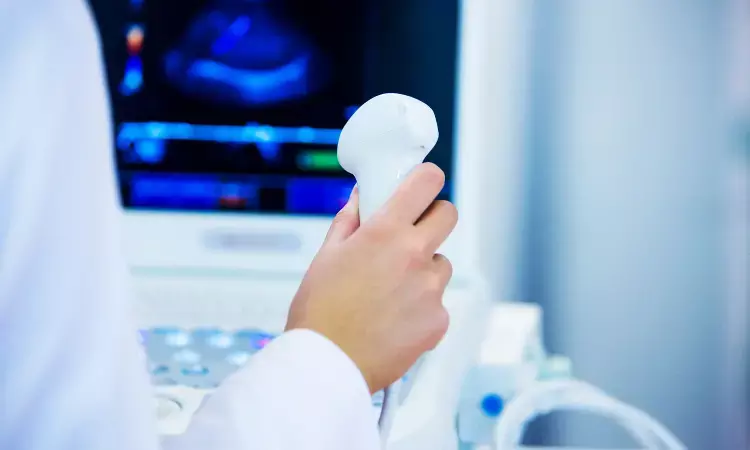- Home
- Medical news & Guidelines
- Anesthesiology
- Cardiology and CTVS
- Critical Care
- Dentistry
- Dermatology
- Diabetes and Endocrinology
- ENT
- Gastroenterology
- Medicine
- Nephrology
- Neurology
- Obstretics-Gynaecology
- Oncology
- Ophthalmology
- Orthopaedics
- Pediatrics-Neonatology
- Psychiatry
- Pulmonology
- Radiology
- Surgery
- Urology
- Laboratory Medicine
- Diet
- Nursing
- Paramedical
- Physiotherapy
- Health news
- Fact Check
- Bone Health Fact Check
- Brain Health Fact Check
- Cancer Related Fact Check
- Child Care Fact Check
- Dental and oral health fact check
- Diabetes and metabolic health fact check
- Diet and Nutrition Fact Check
- Eye and ENT Care Fact Check
- Fitness fact check
- Gut health fact check
- Heart health fact check
- Kidney health fact check
- Medical education fact check
- Men's health fact check
- Respiratory fact check
- Skin and hair care fact check
- Vaccine and Immunization fact check
- Women's health fact check
- AYUSH
- State News
- Andaman and Nicobar Islands
- Andhra Pradesh
- Arunachal Pradesh
- Assam
- Bihar
- Chandigarh
- Chattisgarh
- Dadra and Nagar Haveli
- Daman and Diu
- Delhi
- Goa
- Gujarat
- Haryana
- Himachal Pradesh
- Jammu & Kashmir
- Jharkhand
- Karnataka
- Kerala
- Ladakh
- Lakshadweep
- Madhya Pradesh
- Maharashtra
- Manipur
- Meghalaya
- Mizoram
- Nagaland
- Odisha
- Puducherry
- Punjab
- Rajasthan
- Sikkim
- Tamil Nadu
- Telangana
- Tripura
- Uttar Pradesh
- Uttrakhand
- West Bengal
- Medical Education
- Industry
New integrated robot system okay for ultrasound-guided prostate percutaneous intervention

A research team from Harbin Institute of Technology has proposed a novel and effective robot system for ultrasound-guided prostate percutaneous intervention. The 8-joint robot system can realize a full-automatic control for prostate insertion, which can be potentially applied to prostate diagnose and treatment such as biopsy and brachytherapy. This study can be found in the journal Frontiers of Mechanical Engineering on January 27, 2022.
As the patient group with prostate disease increases greatly in recent years, the novel and rigid robot system provides a hopeful alternative for automatic intervention process with less attempts and trauma, and also depending less on operators' experience.
"The compact system makes use of the limited space for prostate insertion operation. The robot system contains 8 joints for independent control of ultrasound probe manipulation, needle positioning and needle insertion. The employed parallel structure, importantly, can avoid potential collision between the structure and patient," said by assistant professor Bo Pan, the author of the study.
The research group of Profs. Yili Fu and Bo Pan is one of the pioneer research groups studying medical imaging-guided surgery robot systems in China. The robot systems are designed to meet the complex requirements in surgical process and increase the rate of success. "Applying intelligent systems to assist doctors to realize operations with reduced difficulties is an effective approach to improve our medical treatment process," said by Pan. And this time, the study group is focused on the ultrasound-guided prostate insertion process.
Ultrasound-guided prostate insertion is a generally used process to diagnose and treat prostate diseases. During the insertion process, a doctor needs to scan the gland, insert the needle and check the accuracy at the same time. A tablet can help doctors reduce the operation difficulty; however, it restricts the insertion flexibility. Also, repetitive attempts are usually needed to increase the accuracy, which lead to bigger trauma and uncomfort to patients. The 8-joint robot system proposed in this work is aimed at achieving the whole process automatically.
"The challenging point is that the system should contain all the needed functions with compact and rigid design," explained by Pan. The newly designed system accommodates ultrasound probe and insertion needle. The transrectal ultrasound probe can be manipulated to insert and rotate for prostate scanning; the needle can be orientated and positioned for pose adjustment, and automatically inserted according to the operator's order. All the motions are independent to realize a high reflexibility. The design also considered the general requirements of medical robot design such as self-locking and easy sterilization.
"The parallel structure for needle pose adjustment is a novel design and increases the system rigidity. However, it also needs careful calibration," said by Pan. Calibration is the model parameter identification process and is important for accurate control. Parallel structures calibration cannot be accomplished using universal approaches, and an effective approach is usually related to the specific model. In the work, the researchers propose particle swarm optimization based on the parameter informative values (InfoPSO) for error identification in calibration process. PSO is a nonlinear optimization method with rapid calculation speed, but the calculation results reasonability cannot be guaranteed without a real-time supervision. Combined with parameter characteristics, the identification accuracy can be improved.
To read the full article, check out the following link:
Dr Kamal Kant Kohli-MBBS, DTCD- a chest specialist with more than 30 years of practice and a flair for writing clinical articles, Dr Kamal Kant Kohli joined Medical Dialogues as a Chief Editor of Medical News. Besides writing articles, as an editor, he proofreads and verifies all the medical content published on Medical Dialogues including those coming from journals, studies,medical conferences,guidelines etc. Email: drkohli@medicaldialogues.in. Contact no. 011-43720751


